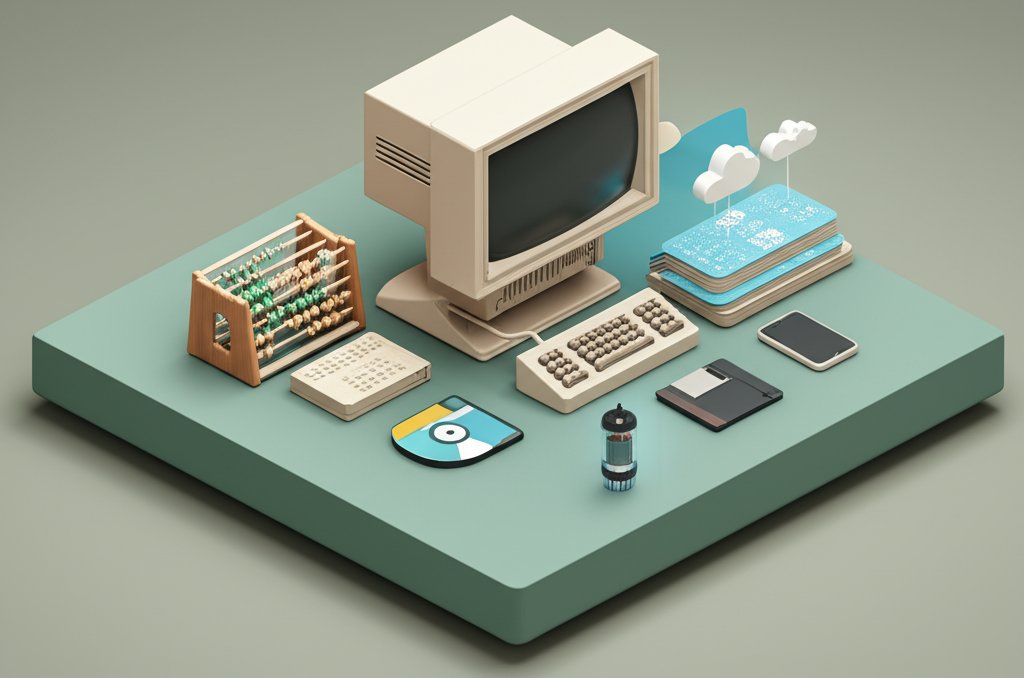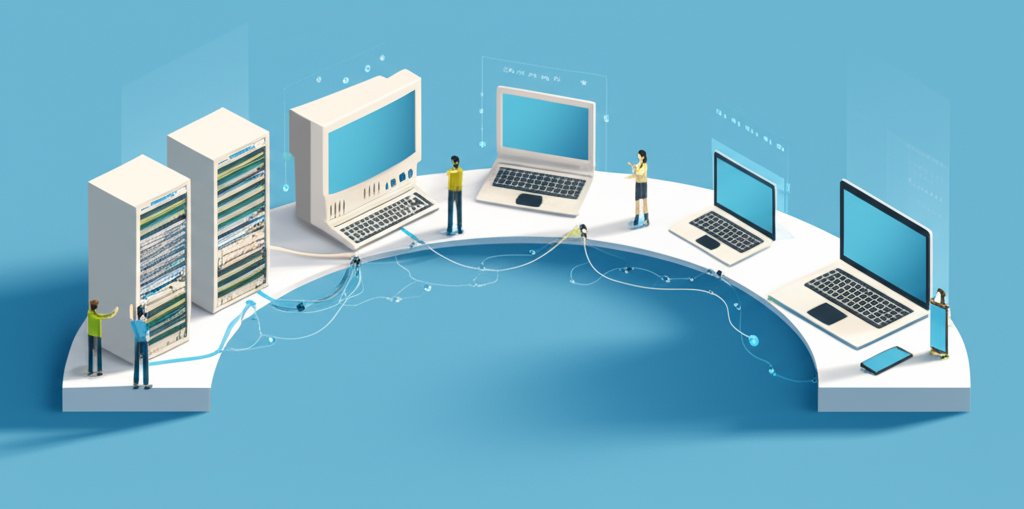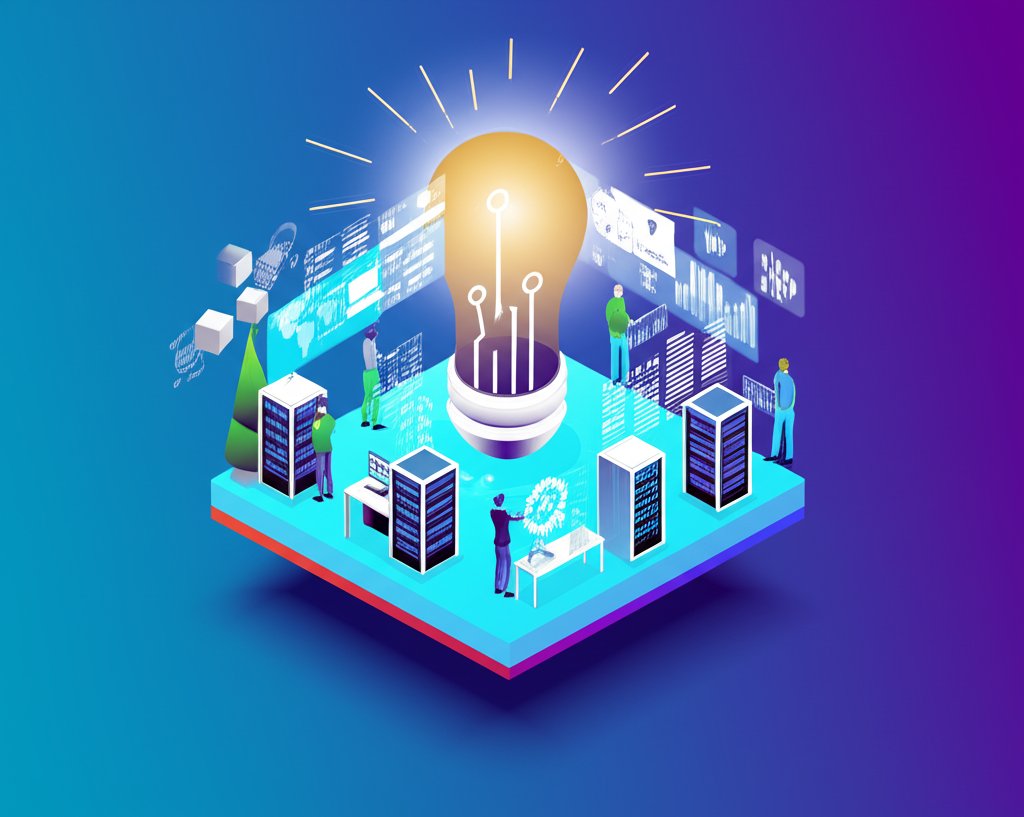Ever wondered how the sophisticated device you’re using right now came to be? From humble counting aids to the powerful artificially intelligent systems of today, the journey of computational technology is a testament to human ingenuity. This article delves into the fascinating sejarah komputer (history of computers), tracing the incredible evolusi komputer (evolution of computing) through pivotal tonggak sejarah teknologi (technological milestones) and the groundbreaking perkembangan komputer (computer development). We’ll explore the brilliant minds, the revolutionary inventions, and even the astonishing capabilities of komputer kuno (ancient computers) that set the stage for our digital world. Prepare to embark on a captivating chronicle that reshaped civilization, making the impossible, routine.
The Dawn of Calculation: From Abacus to Ancient Computing

Before the hum of electronics, humanity sought ways to quantify and calculate. The earliest forms of computing were simple yet profound, laying the intellectual groundwork for everything that followed. This era of komputer kuno showcases ingenuity born of necessity.
The leap from these early calculation methods to modern machines is remarkable, and understanding that progression highlights many interesting facts about technology that we often take for granted today.
The Abacus: Humanity’s First Digital Tool
Originating as far back as 2700 B.C. in Mesopotamia, the abacus stands as one of the earliest known calculating devices. Composed of beads sliding on rods or grooves, it allowed for quick and efficient addition, subtraction, multiplication, and division. Though mechanical, its discrete “on” or “off” state for each bead makes it conceptually a precursor to digital computation. Its widespread adoption across vast civilizations – from Sumer to China, Rome to Japan – underscores a universal human need to process numerical information more effectively.
The Antikythera Mechanism: An Astounding Analog Computer
Discovered in a shipwreck off the coast of the Greek island Antikythera, this intricate device from around 200 B.C. defies its age. Often hailed as the world’s first analog computer, the Antikythera Mechanism was an astronomical calculator of remarkable complexity. Designed with dozens of interlocking bronze gears, it could predict solar and lunar eclipses, track the positions of celestial bodies, and even mark important athletic games. Its existence reveals a level of mechanical sophistication and astronomical understanding far beyond what was previously attributed to the ancient world, representing a monumental tonggak sejarah teknologi.
Early Mechanical Aids: Napier’s Bones and the Slide Rule
The 17th century saw further advancements in mechanical calculation. John Napier, the inventor of logarithms, introduced “Napier’s Bones” in 1617. This set of numbered rods simplified multiplication and division through a method of movable parts. Shortly after, the slide rule, an analog mechanical calculator, emerged, gaining popularity for its ability to perform rapid multiplication, division, roots, and logarithms without the need for complex calculations. These tools served engineers, scientists, and navigators for centuries, showcasing the ongoing perkembangan komputer precursors.
The Mechanical Revolution: Pioneers of Programmable Machines
The 19th century ushered in a transformative era, moving beyond mere calculation to the conceptualization of programmable machines—devices that could follow a sequence of instructions. These innovators laid the true foundation for the evolusi komputer.
Charles Babbage’s Analytical Engine: The Blueprint for Modern Computing
Charles Babbage, a British mathematician, is widely regarded as the “Father of the Computer.” His visionary designs, particularly the Analytical Engine conceived in 1837, outlined the essential components of a modern general-purpose computer: a “mill” (processing unit), a “store” (memory), and input/output mechanisms. Powered by steam, the Analytical Engine was designed to perform complex calculations and execute programs stored on punched cards. Though never fully built in his lifetime due to technological limitations and funding, Babbage’s detailed plans were a monumental tonggak sejarah teknologi, serving as the theoretical blueprint for all subsequent computer designs.
Ada Lovelace: The First Programmer and the Vision of Algorithms
Collaborating with Babbage, Augusta Ada King, Countess of Lovelace (daughter of Lord Byron), possessed an extraordinary mathematical mind. She not only understood Babbage’s Analytical Engine better than anyone else but also recognized its profound potential beyond mere number crunching. In her notes on the Analytical Engine, she described an algorithm for the machine to calculate Bernoulli numbers, effectively creating what is considered the world’s first computer program. Lovelace foresaw that computers could manipulate symbols, not just numbers, hinting at a future of music, art, and scientific applications – a profound insight into the future perkembangan komputer.
Herman Hollerith and Tabulating Machines: Data Processing for the Census
Towards the end of the 19th century, the growing population of the United States posed a significant challenge for census data processing. Herman Hollerith, an American inventor, developed an electromechanical tabulating machine that used punched cards to record and process data. His system dramatically reduced the time required to complete the 1890 U.S. Census from eight years to just one. Hollerith’s company eventually evolved into International Business Machines (IBM), marking a crucial commercial tonggak sejarah teknologi and the beginning of the sejarah komputer in large-scale data processing.
The Electronic Age: Birth of Modern Computers
The mid-20th century witnessed an explosion of innovation, fueled by the demands of World War II and the subsequent Cold War. This period gave birth to the first true electronic computers, catapulting the evolusi komputer into a new, fast-paced era.
Vacuum Tubes and the First Generation: ENIAC and UNIVAC
The first generation of electronic computers, spanning roughly from the 1940s to the mid-1950s, relied on thousands of vacuum tubes for their circuitry. These machines were massive, consumed enormous amounts of power, and generated considerable heat. Iconic examples include the Electronic Numerical Integrator and Computer (ENIAC), completed in 1946, which could perform 5,000 additions per second, and the Universal Automatic Computer (UNIVAC I), the first commercial computer produced in the U.S. in 1951. These behemoths marked the shift from mechanical to electronic computation, a defining tonggak sejarah teknologi.
The Transistor Era: Miniaturization and Reliability
In 1947, Bell Labs physicists John Bardeen, Walter Brattain, and William Shockley invented the transistor. This tiny, solid-state device could amplify and switch electronic signals, performing the same function as a vacuum tube but with far less power, heat, and space. The invention of the transistor ushered in the second generation of computers (mid-1950s to early 1960s), making them smaller, faster, more reliable, and more affordable. This breakthrough was a monumental perkembangan komputer, allowing for widespread adoption in scientific and business applications.
Integrated Circuits: The Microchip Revolution
The third generation of computers (mid-1960s to early 1970s) was defined by the integrated circuit (IC), or microchip, invented independently by Jack Kilby and Robert Noyce in 1958. An IC combines multiple transistors and other electronic components onto a single, tiny slice of silicon. This innovation led to an unprecedented level of miniaturization, increased processing speeds, and drastically reduced manufacturing costs. Computers like IBM’s System/360 became commercially viable, signaling a massive acceleration in the sejarah komputer.
The Microprocessor: A Computer on a Chip
The ultimate expression of miniaturization came with the invention of the microprocessor in 1971 by Intel’s Federico Faggin, Marcian Hoff, and Stanley Mazor, led by Ted Hoff. The Intel 4004 was the first commercially available single-chip microprocessor, containing all the central processing unit (CPU) components on a single integrated circuit. This fourth generation tonggak sejarah teknologi made it possible to build truly personal computers, making computing accessible to individuals and small businesses, thus dramatically transforming the evolusi komputer landscape.
Personal Computing and the Digital Transformation

With the microprocessor paving the way, the late 20th century saw computing transition from specialized mainframes in corporate and academic settings to machines on every desk, transforming daily life and global connectivity. This era is a crucial chapter in the perkembangan komputer.
The Rise of Personal Computers: Apple, IBM, and Microsoft
The 1970s and 80s witnessed the explosion of personal computers (PCs). Companies like Apple, with its Apple II and Macintosh, and IBM, with its IBM PC, democratized computing. These machines were designed for individual users, bringing computing power into homes and small offices. The competition spurred rapid innovation in hardware and software, making PCs more powerful and user-friendly. The IBM PC’s open architecture also fostered a thriving ecosystem of compatible hardware and software, with Microsoft’s MS-DOS becoming the dominant operating system, fundamentally reshaping the sejarah komputer.
The Graphical User Interface (GUI): Making Computers Accessible
Early personal computers still required users to type complex commands. The invention of the Graphical User Interface (GUI) by Xerox PARC researchers (later popularized by Apple’s Macintosh in 1984 and Microsoft Windows) revolutionized user interaction. GUIs used visual elements like icons, menus, and windows, allowing users to interact with computers intuitively using a mouse. This tonggak sejarah teknologi broke down barriers, making computers accessible to a much broader audience and fueling their mass adoption, a significant step in the evolusi komputer.
The Internet and World Wide Web: Global Connectivity
While ARPANET laid the groundwork in the late 1960s, the true advent of the Internet as a public utility came in the 1990s with Tim Berners-Lee’s invention of the World Wide Web. The Web provided an easy-to-use, interconnected system of documents and information, accessible via web browsers. This global network transformed communication, commerce, education, and entertainment, turning computers into gateways to an unprecedented wealth of information and transforming society in ways previously unimaginable. This was arguably the most significant perkembangan komputer in terms of global reach and impact.
Modern Computing: AI, Cloud, and Beyond
Today, the sejarah komputer continues at an electrifying pace, characterized by pervasive connectivity, intelligent systems, and seamless integration into every aspect of our lives. These advancements propel the evolusi komputer towards a future once considered science fiction.
The Mobile Revolution: Smartphones as Ubiquitous Computers
The early 21st century brought about the mobile computing revolution, with smartphones becoming indispensable tools. These devices, descendants of early “mobile brick” phones, pack supercomputer-level processing power into our pockets, offering internet access, multimedia, and an ecosystem of applications. From communication to navigation, entertainment to banking, smartphones epitomize the fifth generation of computing, making personal computing truly ubiquitous and always-on.
Cloud Computing: Computing as a Utility
Cloud computing represents a paradigm shift where computing resources (servers, storage, databases, networking, software, analytics, and intelligence) are delivered over the internet (“the cloud”) on a pay-as-you-go basis. Instead of owning and maintaining their own computing infrastructure, individuals and businesses can access powerful, scalable resources on demand. This tonggak sejarah teknologi has democratized access to high-end computing, fueled startups, and enabled flexible work models, becoming a cornerstone of modern digital infrastructure.
Artificial Intelligence and Machine Learning: The Next Frontier
Artificial Intelligence (AI) and Machine Learning (ML) are not new concepts, but recent advancements in processing power, algorithms, and vast data sets have propelled them to the forefront of the perkembangan komputer. AI allows machines to perform tasks that typically require human intelligence, such as learning, problem-solving, decision-making, and understanding language. From voice assistants and recommendation engines to self-driving cars and medical diagnostics, AI is transforming industries and daily life, marking the beginning of a new, intelligent era in the sejarah komputer. The future promises even more sophisticated intelligent systems, continuing the ever-accelerating evolusi komputer.
Conclusion: An Unfinished Symphony of Innovation
The sejarah komputer is a breathtaking saga of human ingenuity, relentless curiosity, and groundbreaking tonggak sejarah teknologi. From the rudimentary komputer kuno like the abacus and Antikythera Mechanism, through the mechanical marvels of Babbage and Lovelace, to the electronic giants, personal computers, and the global connectivity of the internet, the evolusi komputer has continuously reshaped our world.
Today’s powerful smartphones, cloud infrastructure, and burgeoning artificial intelligence are merely the latest chapters in this ongoing perkembangan komputer. As technology continues its exponential growth, we stand on the precipice of even more astonishing discoveries and transformations. The journey has been long, but the future of computing promises to be even more revolutionary, driven by visionary minds charting new frontiers.
FAQ
Q1: What are some of the key milestones in the evolution of computers?
A1: Key milestones include the invention of the abacus (first digital computer), the Antikythera Mechanism (first analog computer), Charles Babbage’s Analytical Engine (blueprint for modern computers), the transistor (replacing vacuum tubes), the integrated circuit (microchip), the microprocessor (computer on a chip), the personal computer, the graphical user interface (GUI), the World Wide Web, and more recently, smartphones, cloud computing, and artificial intelligence.
Q2: How did the invention of the microprocessor contribute to the development of modern computers?
A2: The microprocessor, invented in 1971, put the entire central processing unit (CPU) on a single integrated circuit. This crucial tonggak sejarah teknologi dramatically miniaturized computers, reduced their cost, and increased their power, making personal computers (PCs) feasible and accessible to individuals and small businesses, thus sparking the modern computing revolution.
Q3: What role did GUIs (Graphical User Interfaces) play in making computers more accessible to the general public?
A3: GUIs transformed computer interaction by replacing complex, text-based commands with intuitive visual elements like icons, menus, and clickable buttons. This approach, popularized by systems like Apple Macintosh and Microsoft Windows, made computers much easier to learn and use, breaking down barriers for non-technical users and accelerating mass adoption.
Q4: How has the development of the Internet impacted the way we live and work?
A4: The Internet, especially with the advent of the World Wide Web, has profoundly impacted daily life and work by enabling global, instantaneous communication, unprecedented access to information, and the rise of e-commerce, remote work, online education, and social networking. It transformed isolated computers into connected gateways to a vast amount of resources and services.
Q5: Describe the evolution of mobile phones from cumbersome “bricks” to today’s sleek smartphones.
A5: Early mobile phones, often called “bricks,” were large, heavy, and primarily used for voice calls. Their evolusi komputer journey saw advancements in miniaturization, battery life, and network technology. The introduction of smartphones marked a revolution, integrating powerful microprocessors, operating systems (like iOS and Android), internet access, cameras, and app ecosystems into compact, touch-screen devices. They evolved from basic communication tools into ubiquitous, multi-functional personal computers that are integral to modern living.










